When marketers and manufacturers choose ethnic interior design for their roomsets, they usually aim at the subconscious part of our brains. Ethnic motives are rooted in ancient traditions that have existed for more than thousands of years. Therefore, we subconsciously perceive ethnic interiors as something familiar and cozy. In other words, they speak home to us.
Surely, creating actual ethno-inspired room sets is very expensive and laborious. Firstly, not every stylist has an in-depth understanding of the subject and can correctly choose decor and materials. Secondly, they have to hunt for authentic items all over the Internet and antic stores, which again takes plenty of money and time.
With 3D technologies, though, making ethnic interiors is much easier. Professional CG artists have libraries of 3D models of many styles and colors, as well as texture catalogs with ethnic materials and textures. Moreover, if there are no 3D items or textures in the library they need, CG experts can easily make custom ones from scratch.
In short, a 3D rendering company can create any type of ethnic interior design, and its CG experts are limited only by their clients’ imagination. You just choose what style you need, and they do the rest. To help you pick the best interior design for your product, we made a guide to the 6 most popular ethnic styles. Grab a coffee and dive into reading!
1. Moroccan
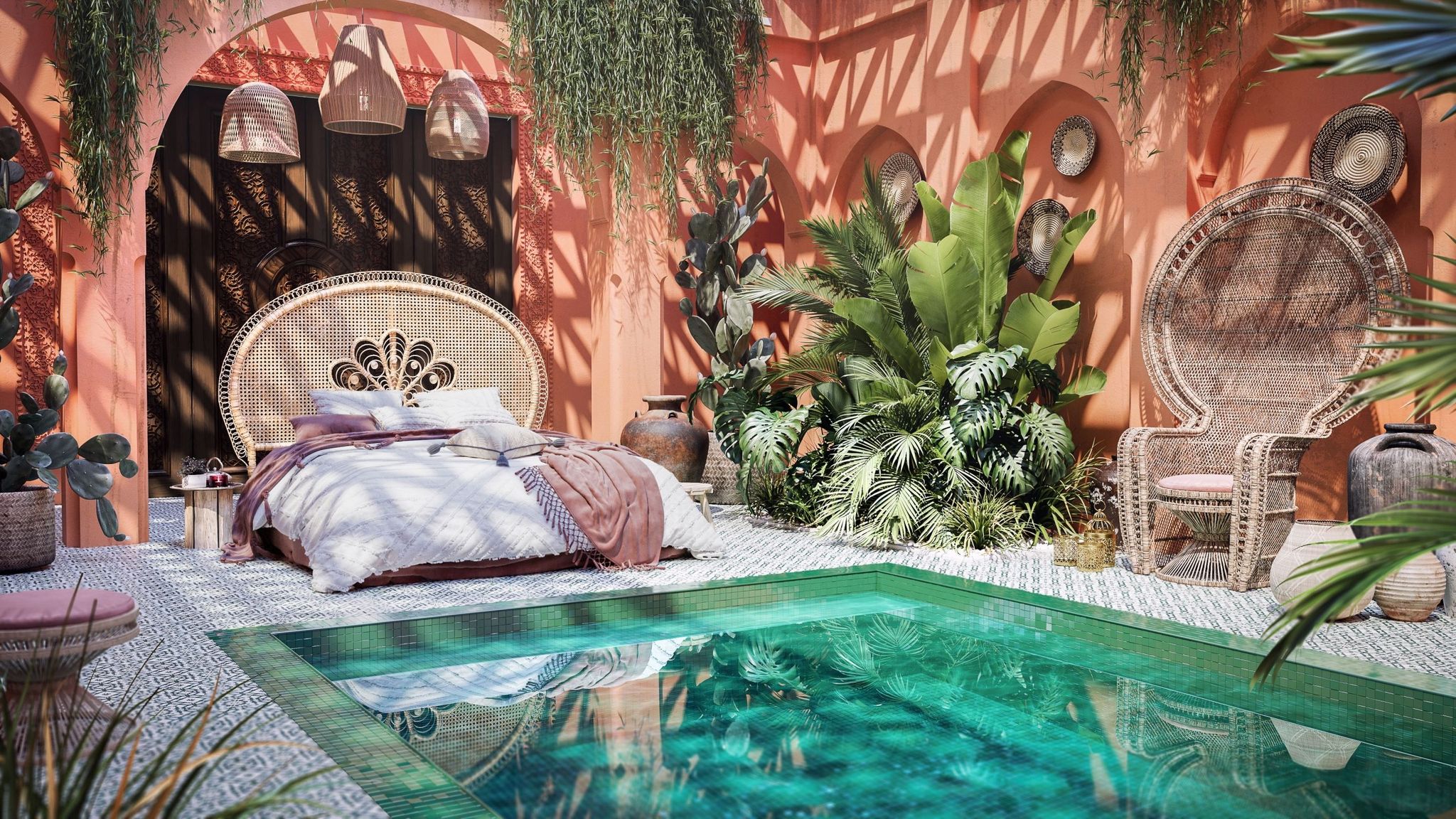
Morocco is a country that brings together many oriental cultures and ethnic groups — from Berbers to Jews to Arabs. Also, the whole Mediterranean region influences Moroccan culture because of the long history of trade. Therefore, you can see those features blend in with the architecture, interiors, and art of Morocco.
Moroccan interior design became especially popular in the 60s after European tourists discovered Morocco and started buying Moroccan goods — that’s how this culture spread throughout Europe. Famously, one of the most ardent fans of Morocco was the legendary Yves Saint Laurent, and this love of Moroccan culture was reflected in his fashion collections.
Such ethnic interiors are considered to be one of the subspecies of the Arabian interior design style. Surely, they do have a lot in common. For instance, both styles celebrate bright colors, fluid lines, traditional Islamic arches, and geometric patterns. And, of course, Arabian and Moroccan interior designs both traditionally include many floor seating cushions, low platforms, and layers of carpets and textiles.
However, when CG artists work on Moroccan interiors using lifestyle 3D product rendering services, they take into account the special multiculturalism of Morocco. They combine simple local materials and various decor motives with luxurious decor. Let’s say, they can use terracotta walls, unpolished stone and rustic wooden beams for the finishing of the interior, but decorate it with opulent textiles and intricate mosaics.
Also, one of the striking differences between the Arabian and Moroccan styles is that the Arabian is much more extravagant and uses only luxurious furnishings, decor, and textiles. While in Moroccan homes, both expensive and handwoven fabrics co-exist peacefully. In other words, the Moroccan ethnic interior is vibrant but comfortable and grounded at the same time.
2. Japandi
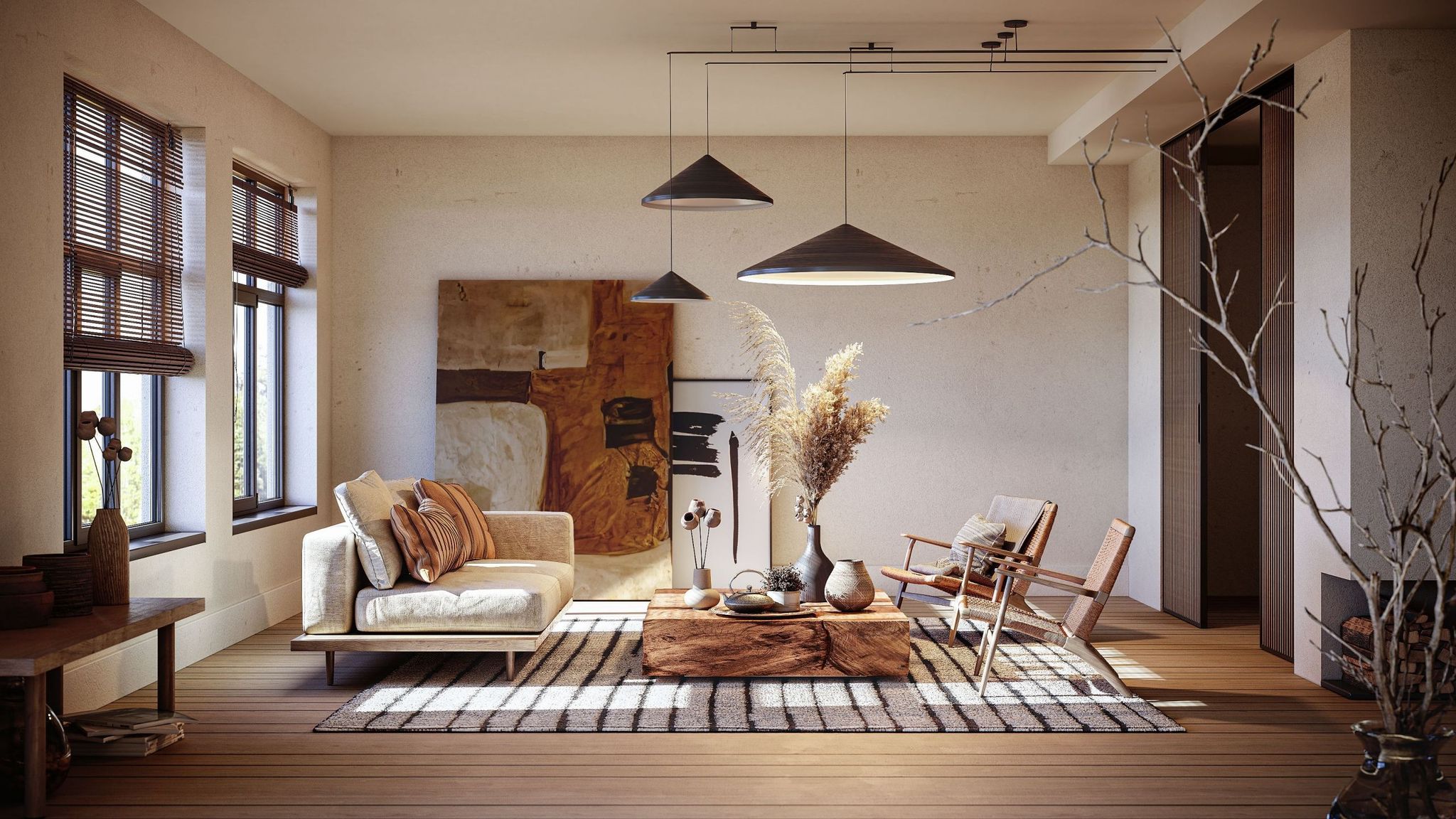
Japandi is a new interior design trend that many fans of minimalism are eager to try this year. The word “Japandi” comes from combining “Japanese” and “Scandi” which perfectly reflects the essence of this ethnic interior design style. Both Japanese and Scandinavian interiors are calm and simple. With Scandinavian functionality and Japanese subtlety, this interior serves as a serene sanctuary that also has all the conveniences modern people need.
When CG artists create this look, they opt for natural materials only and put great emphasis on wood. Using various types of wood for floors, window blinds, furniture, and decor adds even more depth and warmth to the space.
Naturally, Japanese ethnic decor and art play a big role in Japandi interior design. CG artists use ikebana arrangements, stone garden elements, and Asian pottery and crockery to celebrate the simplicity and poetics of the Japanese lifestyle. As for the Scandi part, it could be reflected in comfy Western furniture, modern abstract artworks, and sleek light fixtures.
3. Arabian

When you say Arabian interior, you expect the luxurious and mystique ambiance of Arabian Nights stories, don’t you? Surely, this ethnic chic interior design glorifies abundance and opulence and also uses layers of plush textures to create that special magic. Arabian interior design is based on expensive marble, redwood, gold, copper, silk, brocaded fabric, velvet….all the most luxurious materials you can ever imagine.
No doubt, climate always defines the architecture and interior design of any tradition. Because of the hot Arabian climate and desert landscape, CG decorators use cooling stone for floors such as marble or granite, as well as ceramic tiles and mosaic flooring. Earlier in history, the whole Arab world wasn’t using traditional high-profile seating because floors were a much more comfortable and cooler place to sit on.
Now everything has changed and you see lots of Western furnishings, such as sofas, dinner and side tables in Arabian modern interior design . But Arabs never fully switched to Western furniture. Instead, they combine them with their pieces such as small inlaid polygonal tables, divider screens with ethnic patterns and Quran stands.
As for a color palette for exotic Arabian ethnic interior design, CG artists boldly use all the most saturated and vibrant colors you’ve ever heard of. Those could be rich rust, peachy coral, glittering gold, deep purple, chocolate, emerald and olive, ultramarine blue, and turquoise to name a few.
4. Zen
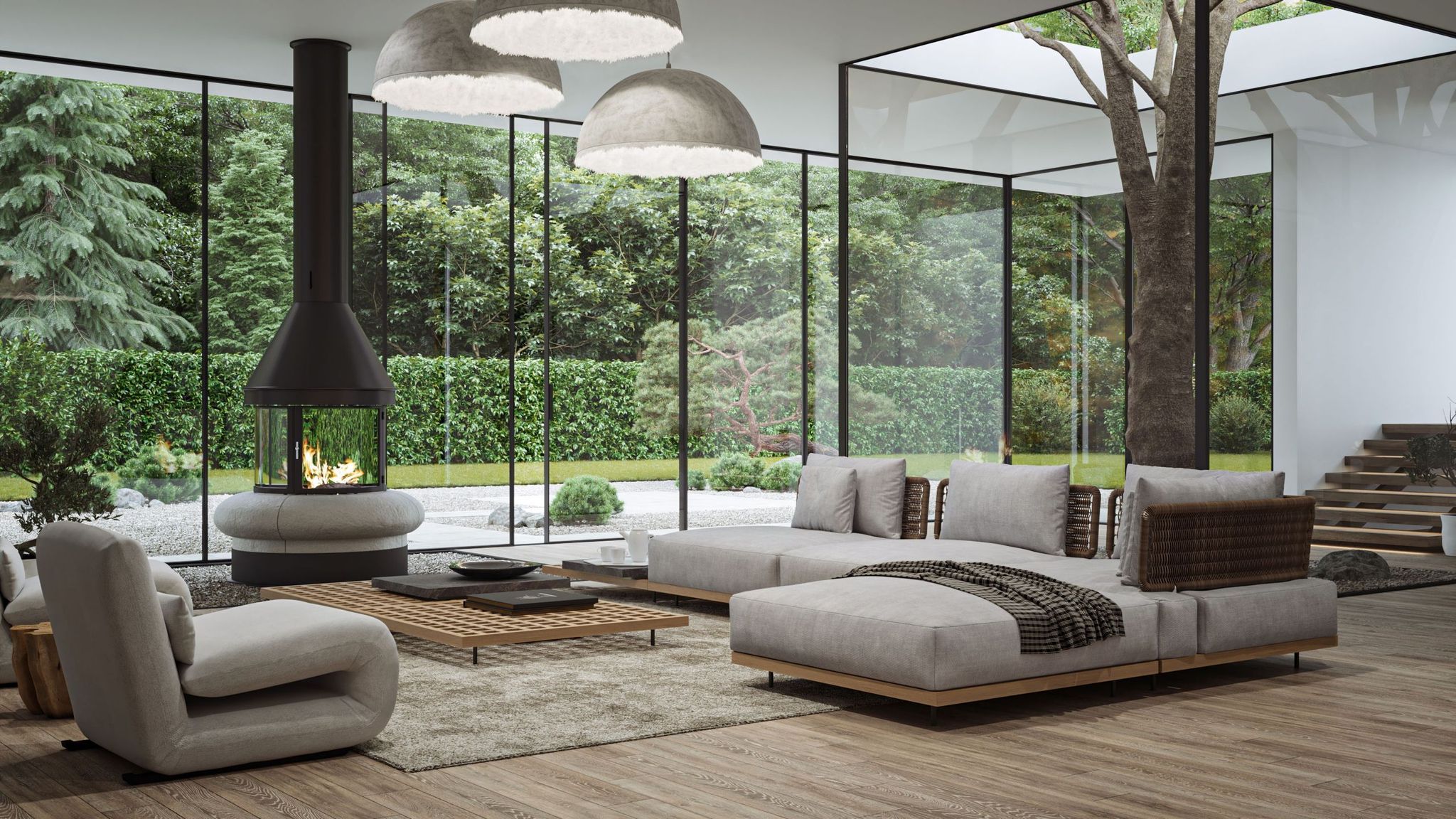
First of all, what is Zen exactly? To put it simply, Zen is a school of Buddhism that is based on various spiritual practices. One of the keystones of Zen Buddhism is dhyana or meditation. Therefore, calmness and silence are the main components of Zen ethnic interior design.
Such roomsets should be clean and simple with a minimum of furniture. That’s why all the storage must be built-in and concealed — CG decorators try to avoid clutter by all means. For the same reason, they don’t use nonsense decor even if it is nice and nostalgic. In terms of Zen interior design, such items only add chaos and disorder to the room. And according to Zen, nothing should disturb the natural harmony of the space.
To create well-balanced Zen roomsets, CG artists use only a restricted color palette with no bright accents. They also opt for natural materials and textures such as stone, cypress or cedarwood, ceramic, textiles, straw tatami mats, and such.
Speaking of nature, one of the most important features of this ethnic interior style is an in-and-out principle. It means that the indoors should blend in with the outdoors to create a peaceful environment. For that, CG artists start with architectural planning and include large windows and sliding door 3D rendering that lead to a garden or patio. Then, they add lots of plants in pots all over the house.
Last but not least, they build small indoor gardens — whether it’s a garden of stones, a little pond, or even a single-standing tree in the middle of the interior. According to Zen philosophy, such a small oasis makes a perfect concentration point so that the owner may meditate freely and calm their mind.
5. Chinese Modern
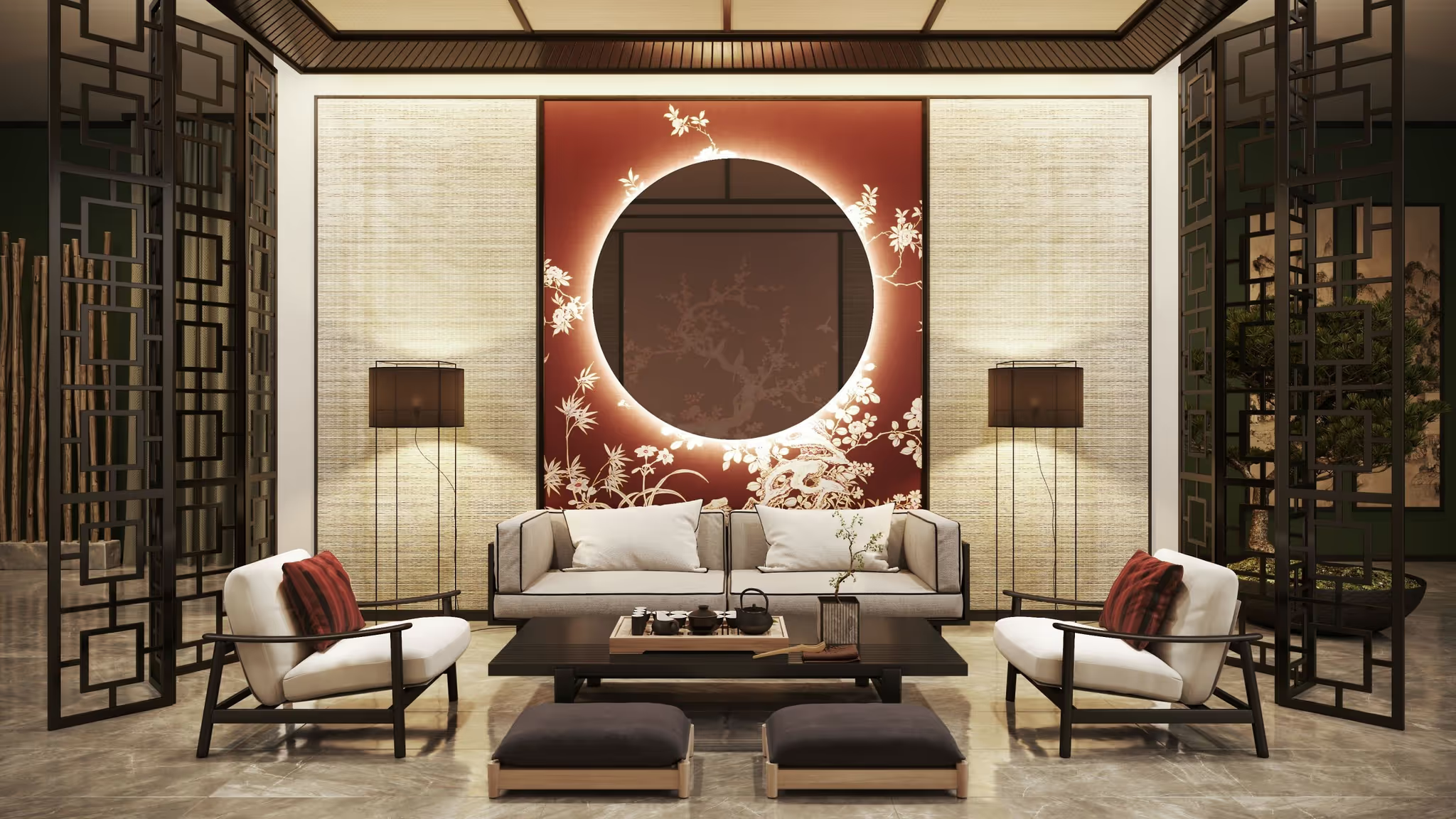
Chinese Modern style is not 100% traditional Chinese interior design. It is rather a mix of modern world interior trends and Chinese ethnic elements. In short, this style mostly represents the modern China that Westerners expect to see.
Although Zen and Chinese Modern are both Asian styles, you can’t confuse this luxurious ethnic interior design with the minimalism and detachment of Zen. When creating a Chinese Modern interior, CG artists opt for sumptuous materials, furnishings, and decor pieces to enhance the wealth of China. For that, they use marble for floors, expensive wood for furniture and millwork, handcrafted paper, silk for upholstery, and divider screens.
In terms of color palettes, of course, the first thing that comes to mind for the Chinese interior is the abundance of red, the most sacred color in Chinese history. However, in addition to various shades of red, CG artists also use gold, black and white for Chinese modern ethnic interiors. As for patterns, they pick recognizable Chinese geometric ornaments and motives that are based on straight lines.
When it comes to furniture and decor for this kind of interior design, CG artists opt for contemporary furniture that comes from the West and adds ethnic Asian decorative elements. These could be Chinese dragons and turtle figurines, Buddha sculptures, traditional Chinese ink paintings, silk room screens, and so on.
6. Indian
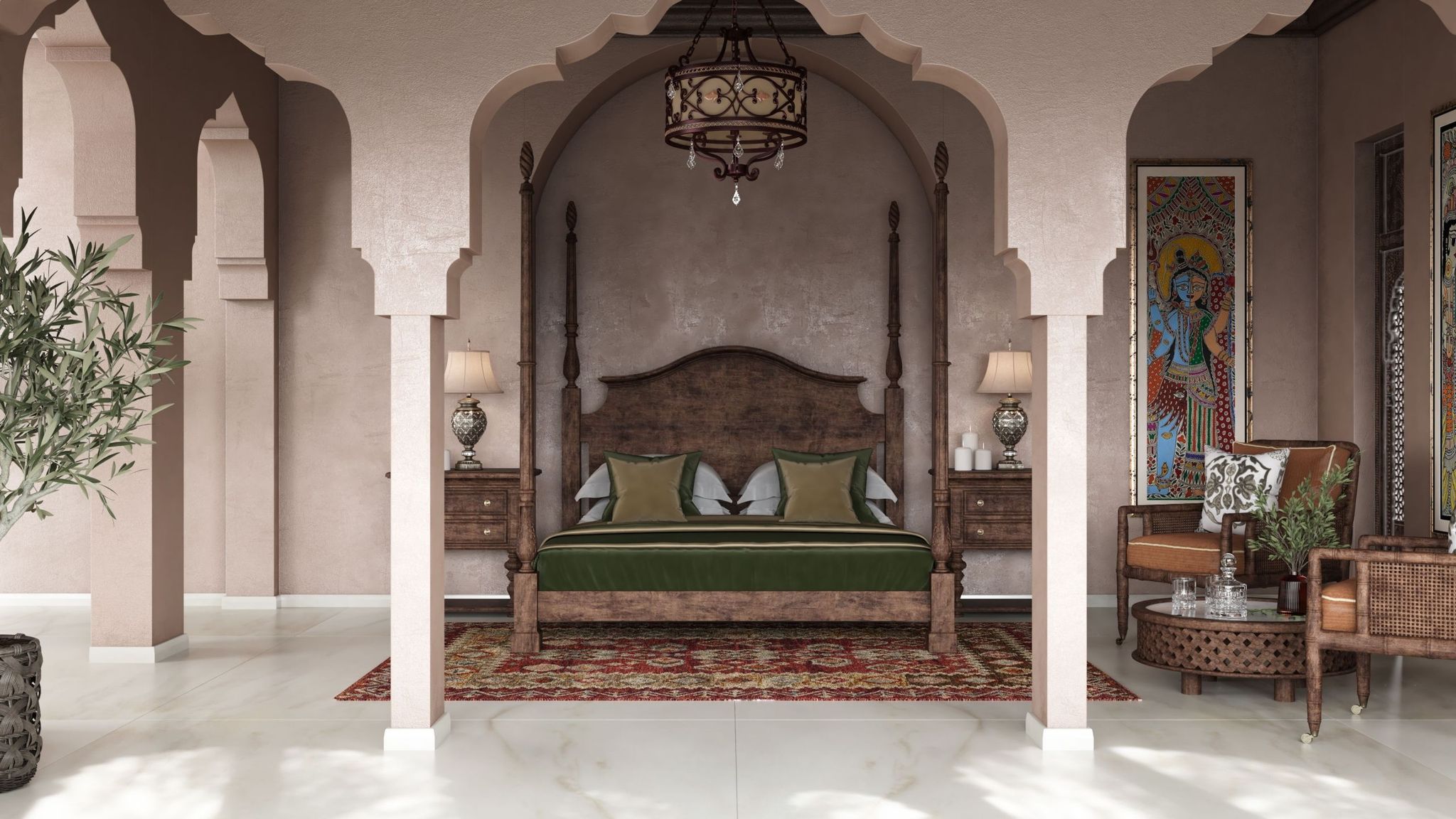
India has a long and rich history of being a mother of many nations and cultures, as well as a global spiritual leader. It is a multicultural environment where the practicality of modern megalopolises harmoniously co-exists with the subtle spirituality of the Himalayas. This is a country of abundance — starting from languages and religions to architectural and decorating traditions.
Creating such an interior, CG artists keep in mind that Indian ethnic interiors celebrate bright flamboyant colors — purple, ocher yellow, golden, red, emerald — literally, all of them! Indians boldly use contrasting patterns and colors in any combination to bring joy and playfulness to their ethnic interior design.
As for furnishings for Indian interiors, CG artists use carved wooden or stone furniture inlaid with mother-of-pearl, ivory, stone, or metal. And, of course, the Indian ethnic patterns can’t be confused with anything — they are intricate and always heavily embellished.
Finally yet importantly, traditionally, these ethnic interiors have a great emphasis on spirituality. Therefore, CG specialists add artworks and statuettes of gods and goddesses both Hindu and Buddhist into an Indian ethnic room set.
Well-educated CG artists know the features of all ethnic interior design styles so they can recreate any of them in 3D. For that, they utilize their libraries of ready 3D models or create 3D ethnic furniture and decor from scratch. Moreover, CG experts not only use furnishings that are specific to a particular culture but balance them out with modern elements to create sleek ethno-inspired trendy roomsets.
Excited to try stunning ethnic 3D lifestyles for your product? Contact us for 3D modeling services right now and get photorealistic roomsets in any of these 6 styles in just two days!
